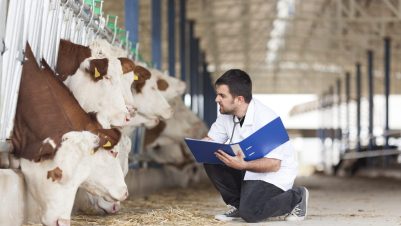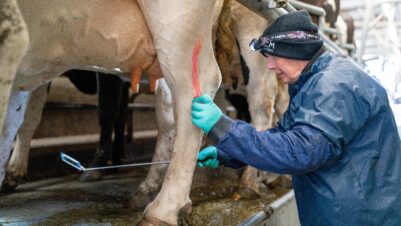In 2024, the British Mastitis Conference (BMC) will be held at Sixways Stadium, Worcester, with the main gathering on Wednesday 12 June and a workshop on Tuesday 11 June. This follows this year’s successful experiment of moving the event away from the autumn, so it looks as though June will be the BMC’s target month in future.
The 2023 event was also unusual in that each speaker had never presented at the BMC before. Some of the topics were familiar to delegates but given a fresh level of enthusiasm – not easy to achieve after 35 years of addressing the many developments in the control of mastitis! One in five delegates were from veterinary practices, with universities and research groups mingling with specialists and company folk and a wide range of interests and new developments discussed.
Poster presentations
The BMC has, for many years, offered an opportunity for researchers and others to present posters under the title of research updates and knowledge transfer. Four of the topics are presented at the conference and there is much discussion of the posters’ content during lunch and coffee breaks. Delegates vote for the best poster and this year, the team from the University of Liverpool received the most ticks. However, the chairman, Ian Ohnstad (The Dairy Group), commented that the standard was very high and that it was “a close-run thing”.
Pre-dip or teat wipe?
In the winning poster, Helen Williams described a trial with a 195-cow herd where evaluation of milking performance was carried out where the cows received a pre-dip and paper towel or a commercial teat wipe.
It was felt that the teat wipe gave less friction to the teat than a paper towel but that the operator appeared to be more thorough with the pre-dip and towel
The results indicated that there were small differences between the two procedures with measurements of the volume of milk produced in the first two minutes of milking, bimodal milk flow and milking machine on time. It was felt that the teat wipe gave less friction to the teat than a paper towel but that the operator appeared to be more thorough with the pre-dip and towel. A finding that 58 percent of farms do not foremilk was not challenged and may become an accepted general finding for future assessment.
Teat condition and hyperkeratosis
Carl Oskar Paulrud (DeLaval International, Sweden) addressed the role of teat condition and hyperkeratosis with emphasis on internal skin turnover. Low flow periods of milk during milking risk internal skin removal and should be avoided. A milking machine may be set up for average milk flow or peak milk flow whereas it would be advantageous to have flow-response milking. A low flow of milk would lead to a low vacuum level.
It was pointed out that cows’ four teats do not milk out at the same time, therefore to take off a unit according to flow would improve udder health. Setting up the milking machine to operate at one vacuum level is a compromise that may disadvantage some cows in a herd with variable milk volumes and milk flow. The speaker indicated that flow-response milking is worthy of consideration.
Behaviour change and motivation
There was a moment of amusement when Vibeke Fladkjaer Nielsen outlined an understanding of ways of changing behaviour and motivating farmers to implement new ideas. In the translation of her slides, a take-home message was shown as a “take-home massage”. The notion of an end-of-day massage for farmers and vets was considered to be an unusual approach, but we are always open to new ideas. It will be interesting to learn whether the delegates have experimented!
There is a period of 30 minutes per day when new ideas are best received and that automatic behaviour, […] dominates the working day. People are more receptive in the morning when there is less pressure
However, this levity did not detract from the recognition that many farmers find it difficult to maintain disease prevention in the absence of disease. Research has shown that there is a period of 30 minutes per day when new ideas are best received and that automatic behaviour, including knowledge, experience, instincts and habits, dominates the working day. People are more receptive in the morning when there is less pressure.
Managing organic herds – from sustainability to mastitis
Will Armitage, a farmer from Leicestershire (Keythorpe Lakes farm), gave a realistic account of managing three organic herds with a total of 530 cows.
Great emphasis is placed on nurturing soil biology – the idea is to feed microbes, not cows. Dead soils are not acceptable for cows and the promotion is “keep it green”. There was no doubting Will’s enthusiasm and attention to detail.
The best cow produced 86 kilograms of milk per day at peak and a total of 176 tonnes of milk. Mastitis is managed using Uddermint and anti-inflammatories. The speaker emphasised that the no-antibiotics approach is “OK for mastitis but a problem for hoof infections”. The herds average 4.7 cases of mastitis per 100 cows, but there is a higher percentage (4.2 percent) of three-quartered cows. The standard two treatments of antibiotics in 12 months per cow can be used.
It is so difficult to translate the performance of a well-managed organic herd into action for non-organic herds, so it is best to compare organic with organic. This is worthy of further understanding in future, not least because of the fluctuating fortunes of organic farms and the variable financial returns from milk production.
Space for living – a welfare issue?
Space for living can be of significance for cows as well as humans, and Jake Thompson (University of Nottingham) has put some figures together on the impact of living space and mastitis.
It is crucial to understand that a longer lying time offers a longer opportunity for teat contamination from bedding
Living space includes the areas cows have access to, and some farms offer double the space of other farms. The higher living space was 14 square metres per cow and this gave a greater milk yield, one hour longer of lying time and benefits to the less dominant cows. With 90 percent of the mastitis infections environmental in origin, it is crucial to understand that a longer lying time offers a longer opportunity for teat contamination from bedding. The best option is for more space together with cleaner conditions.
Case studies
Case studies have become a feature of the BMC, where veterinary surgeons and clients present data and experiences.
A mastitis control plan
Bella Cima (Larkmead Vets, Oxfordshire) presented a case control study that used the mastitis control plan of a 460-cow herd.
A somatic cell count of 208,000 for the herd has reduced to 145,000, and an incidence of mastitis from 42 cases per 100 cows to 23. The infections were identified as originating in the dry period and in lactation. Heifers were becoming infected at calving. A total ration feeding system is in operation but machinery breakdowns, particularly of the yard scraper, frustrated efforts to control disease. It was recommended to reduce the stocking rate of the yards and a reduction in dry period infections was recorded. Persistent application of the plan has given a worthwhile improvement over time.
Dry-period cure rates
Further understanding of dry-period cure rates was discussed by Luke Gunter (Royal Veterinary College).
Comparisons of herds with high and low incidences of dry-period infections have indicated that a cow is more likely to have an infection after calving if she was infected in a previous dry period. This recording of repeated dry-period infections highlights the issue of cows that are not likely to respond effectively to treatment. The identification of “unworthy cows” includes an assessment of the previous dry-period history and the equivalent cell count history.
A policy based on the recorded information can be developed on whether to treat or not to treat. This approach is well understood by farmers in relation to clinical mastitis, but adapting this approach to infections without clinical signs may need considerable analysis.
Cell counts
In Ireland one-third of milk-producing herds have cell counts above 200,000 cells per ml. Michelle McGrath (Animal Health Ireland) outlined a training programme, Cell Count Solutions, that involves a multidisciplinary approach to tackle this problem. Following a pilot scheme in 2022, the programme has a national rollout, funded by a rural development plan. There is an initial three-hour “dry cow” consultation by the farm vet where knowledge of the cell count and mastitis incidence is reviewed.
Around 80 percent of herds calve over a six-week period and herds that are milk recording tend to have a lower cell count
Around 80 percent of herds calve over a six-week period and herds that are milk recording tend to have a lower cell count. High cell count herds involve their vet but are also able to choose other advisors including milk quality specialists and milking machine technicians.
Motivation for the farmer to improve is essential. Herd health planning is part of the veterinary role. Initial training for the advisory team is delivered in person, with further training online. The team approach to mastitis has been appreciated by the farmers and a general improvement in the levels of the disease is anticipated across the country.
| Further information and copies of the proceedings are available online. |











